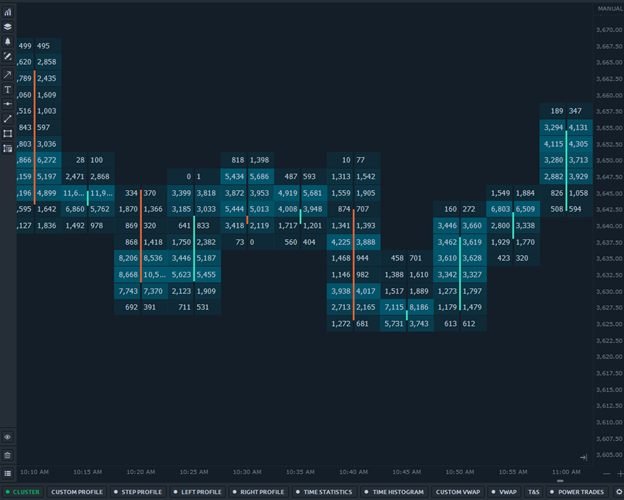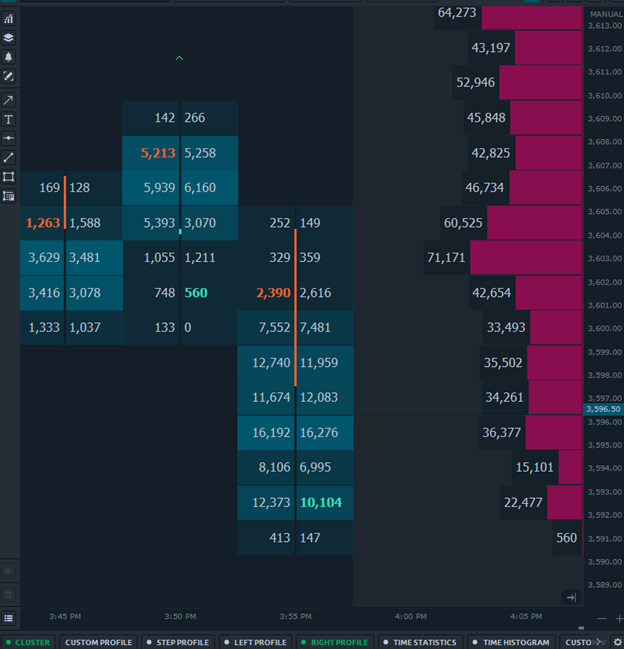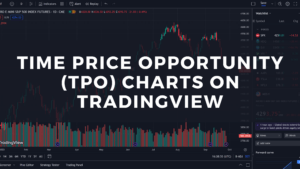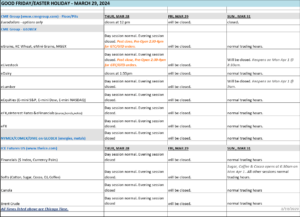This article on Order Flow is the opinion of Optimus Futures.
Editor’s Note: This article was originally published on August 6th, 2016 and has been updated for comprehensiveness.
To understand the mechanism that moves the price up or down we have to learn the interplay between the Depth of Market on one side and Market Orders on the other hand. This interplay is the Order Flow. We used Optimus Flow trading platform for the illustrations.
The Current Price is the last price in which a trade took place. This last trade could have taken place either at the Best Bid Price or at the Best Ask Price. Those two terms will make sense in a minute once we understand what the Depth of Market is.
The Depth of Market is the total size of Limit Buy or Sell orders that are placed at each price. It is often called Liquidity, Limit Orders, Passive Orders or The Book. Take a look at figure #1.
Order Flow Figure #1: The E-Mini S&P 500 DOM ( Optimus Flow Trading Platform.)
In Figure #1 we see the standard visual representation of the Depth of Market. The price ladder that we see in figure #1 is called the DOM which stands for Depth of Market.
This ladder also often serves for placing trade orders and then its proper name is DOME (Depth of Market Execution), but most traders just call it the DOM in both cases.
The left column shows the price. The right column shows the 10 Bid levels and the 10 Ask levels.
The numbers in the Bid and Ask column tell us how many contracts (or stocks or lots) are waiting as limit buy orders (Bids) or as limit sell orders (Asks) at each price.
Different exchanges supply data about a different number of Depth of Market price levels. With futures contracts, we usually get 10 levels of Bids and 10 levels of Asks.
Obviously, there are limit orders placed above the 10 Ask levels that we see and below the 10 Bid levels that we see, but we know nothing about them. The price of the lowest of the 10 Ask levels is called the Best Ask price, and the price of the highest of the 10 Bid levels is called the Best Bid price.
During trading hours the current price fluctuates between the Best Bid Price and the Best Ask Price. In Figure #1 we see that the current price is at the Best Bid price (indicated with the small black triangle).
What this means is that the last trade happened at the Best Bid price. Now comes the point that is most important to understand – no matter how many contracts are waiting as buy limit orders at the Bid levels or as sell limit orders at the Ask levels no trade will ever take place until a Buy or Sell Market order will be placed.
When a trader places a Buy Market order, he is announcing that he wants to buy X contract right now at the Best Ask price. When a trader places a Sell Market order, he is announcing that he wants to sell X contract right now at the Best Bid price.
Buy Market orders are always matched against the Sell Limit orders waiting at the Best Ask price and Sell Market orders are always matched against buy limit orders waiting at the Best Bid price.
Now we can understand why the highest of the bid levels is called the Best Bid and the lowest of the Ask levels is referred to as the Best Ask.
When a trader wants to sell at the market (sell with a Market order) he/she obviously intends to sell at the highest price available, so the highest bid price is his best option. When a trader wants to buy at the market he wants to buy at the lowest possible price and therefore the lowest ask price is his best option.
The Spread is the distance between the Best Bid price and the Best Ask price.
Visualizing the Market orders – Just as the DOM visualizes the Depth of Market data (limit orders) we also have a tool that visualizes the Market orders. The common names for this tool are Cluster Charts, footprint charts, or number bars.
Order Flow Figure #2: Cluster Charts (Optimus Flow Platform)
Figure #2 shows a 5-minute Cluster chart (Optimus Flow). The numbers at each price show Bid Volume x Ask Volume.
The Bid Volume is – The number of Contracts/Stocks/Lots that were sold with market orders when this specific price was the Best Bid price.
The Ask Volume is – The number of Contracts/Stocks/Lots that were bought with market orders when this specific price was the Best Ask price.
Don’t confuse Bid Size/Ask Size with Bid Volume/Ask Volume. The Bid Size/Ask Size is the total Size of limit buy or sell orders that are placed at each price while the Bid Volume/Ask Volume is the total volume of buy or sell market orders that are traded at each price.
While the DOM shows the limit orders that are waiting to get filled the Cluster charts show what actually traded at each price.
So what makes the price move? – Let’s look at figure #3. We see that at the moment this screenshot was taken we had a total of 4 contracts waiting as buy limit orders at the Best Bid price 3596.25 and 2 contracts waiting as sell limit orders at the Best Ask price 3596.75.
The current price is 3596.50. Figure #3 is static but we have to remember is that the numbers on the DOM keep on changing all the time because of two reasons (look for the second in the next section):
Reason # 1: When a trader places a buy market order of X contracts, we will right away see a reduction of contracts from the Ask Size at the Best Ask price on the DOM and an addition of contracts to the Ask Volume at the Best Ask price on the Cluster chart.
When a trader places a sell market order of X contracts, then we will right away see a reduction of contracts from the Bid Size at the Best Bid price on the DOM and an addition of contracts to the Bid Volume at the Best Bid price on the Cluster chart.
Order Flow Figure #3: A DOM attached to a Cluster chart (using Optimus Flow platform)
Example – On figure #3 we have 2 contracts at the Best Ask price (3596.75).
If at this moment a trader places a buy market order of 1 contract we will right away see that the Ask Size will change to 1 because the buy market order of 1 contracts was matched with 1 of the 2 contracts that were waiting as sell limit orders at 3596.75 and they got filled leaving 1 contracts still waiting to get filled against new buy market orders.
On the Cluster chart, we will see that the contracts that were bought so far with market orders at the Best Ask price will change because 1 more contract was just bought at the market.
On the Bid side, we have 4 contracts at the Best Bid price (3596.25). If at this moment a trader places a sell market order of 1 contracts we will right away see that the Bid Size at 3596.25 will change to 3 because the sell market order of 1 contract was matched with 1 of the 4 contracts that were waiting as buy limit orders at 3596.25 and they got filled leaving 3 contracts still waiting to get filled against new sell market orders.
On the Cluster chart, we will see that the contracts that were sold so far with market orders at the Best Bid price 3596.25 will change because 1 more were just sold at market.
Reason # 2: The second reason for the continuous change of the Bid Sizes and Ask Sizes on the DOM is that traders add limit orders and cancel limit orders. Some of the adding and canceling have to do with legit trading decisions, and some reflect manipulation efforts (Spoofing).
So far we understood how price fluctuates between the Best Bid and Best Ask. The next question to ask ourselves is – What is required for the price to move one tick higher to the next Best Ask price or one tick lower to the next Best Bid price?
Order Flow Figure #4:
On figure #4 we see the 2 contracts waiting as limit sell orders at the Best Ask price 3596.75.
If at this moment traders buy 2 contracts at market then all 2 contracts waiting at the Best Ask price will get filled and we will have zero contracts at 3596.25 which will immediately make 3596.75 the new Best Ask price and the next buy market orders will be matched with sell limit orders at the new Best Ask price 3596.75.
The same story applies to the downside. We need 4 contracts to be sold at market in order to get the entire buy limit orders at the Best Bid price 3596.25 filled and then the next sell market orders will be matched against limit buy orders at the new Best Bid price 3596.00.
In liquid markets, there are always limit buy orders waiting at the next bid price of sell limit orders waiting at the next ask price, and therefore price moves in one tick jumps. With less liquid markets the next Best Bid price or next Best Ask price may be more than one tick away, and we may see price jumping more than one tick leaving some price levels untraded behind.
The spread will almost always remain 1 tick in liquid markets (in our experience) because as soon as the Best Ask jump one tick to the upside traders will quickly place buy limit orders at the level that was the previous Best Ask and is now available for the bids.
Or as soon as the Best Bid jump one tick to the downside traders quickly place sell limit orders at the level that was the previous Best Bid and is now available for the asks.
During important economic data releases or news events, traders tend to withdraw limit orders, and the book becomes much “thinner” and then even in liquid markets the spread may increase to more than one tick for a very short time.
Appendix #1 – Advanced Features of the Optimus Flow DOM.
Figure #5 shows the Optimus Flow Chart DOM with a few additional features. You can see 2 new columns.
Figure #5:
The column on the left shows the resting limit orders for the Best Bid price. It sits at 4 contracts. The column on the right shows the resting limit orders for the Best Ask price, it sits at 2 contracts. If you notice that the Best Ask price is coloured at half the length of the Best Bid price. This is because it is in histogram mode.
It is an easy way to visualize whether there are more bids or more asks, in other words; buying vs selling pressure.
Appendix #2 – Advanced Features of Optimus Flow Cluster Charts
Figure #6:
The Cluster chart on Figure #6 displays a few advanced features. The green and red fonts alert us that the diagonal comparison between the Ask Volume, when a price was the Best Ask and the Bid Volume at the accordant Best Bid price, gives a ratio value that is larger than a specific threshold value ( 3 in this case).
The comparison is called an imbalance because the Best Ask price is on the right side of the “x” and is (usually) one tick higher than the Best Bid price on the left side of the “x”. If the Ask Volume is larger than the Bid Volume, then the color is green and if vice versa is then red.
The Numbers Bars are overlaid on top of Volume Profiles that give us a good visualization of the volume distribution within each bar.
Optimus Flow offers all these tools and more for free when you sign up with Optimus Futures Brokerage. Take advantage of all the order flow tools absolutely free for all customers.
There is a substantial risk of loss in futures trading. Past performance is not indicative of future results. When considering technical analysis, please remember educational charts are presented with the benefit of hindsight. Market conditions are always evolving, and technical trading theories and approaches may not always work as intended.





















